Polypurine (A)-rich sequences promote cross-kingdom conservation of internal ribosome entry - PubMed
- ️Tue Jan 01 2002
Polypurine (A)-rich sequences promote cross-kingdom conservation of internal ribosome entry
Yuri L Dorokhov et al. Proc Natl Acad Sci U S A. 2002.
Abstract
The internal ribosome entry sites (IRES), IRES(CP,148)(CR) and IRES(MP,75)(CR), precede the coat protein (CP) and movement protein (MP) genes of crucifer-infecting tobamovirus (crTMV), respectively. In the present work, we analyzed the activity of these elements in transgenic plants and other organisms. Comparison of the relative activities of the crTMV IRES elements and the IRES from an animal virus--encephalomyocarditis virus--in plant, yeast, and HeLa cells identified the 148-nt IRES(CP,148)(CR) as the strongest element that also displayed IRES activity across all kingdoms. Deletion analysis suggested that the polypurine (A)-rich sequences (PARSs) contained in IRES(CP,148)(CR) are responsible for these features. On the basis of those findings, we designed artificial PARS-containing elements and showed that they, too, promote internal translation from dicistronic transcripts in vitro, in tobacco protoplasts and in HeLa cells. The maximum IRES activity was obtained from multiple copies of either (A)(4)G(A)(2)(G)(2) or G(A)(2-5) as contained in IRES(CP,148)(CR). Remarkably, even homopolymeric poly(A) was moderately active, whereas a poly(G) homopolymer was not active. Furthermore, a database search for existing PARS sequences in 5'-untranslated regions (5'UTR) of genes in tobacco genome allowed the easy identification of a number of IRES candidates, in particular in the 5'UTR of the gene encoding Nicotiana tabacum heat-shock factor 1 (NtHSF1). Consistent with our prediction, the 5'UTR of NtHSF1 turned out to be an IRES element active in vitro, in plant protoplasts and HeLa cells. We predict that PARS elements, when found in other mRNAs, will show a similar activity.
Figures
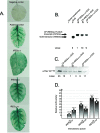
IRES-mediated GUS gene expression in tobacco plants transgenic for
dicistronic CP-IRES-GUS constructs. Five series of transgenic plants
differing in IRES sequences were generated: (I) Negative control:
vector-transformed plants; (II) positive control: plants transgenic for
monocistronic GUS gene; (III–V) IRES,
IRES
, and IRES
elements,
respectively, were used as intercistronic spacers. (A)
Histochemical detection of GUS activity. (B) Northern
blot of total RNA isolated from transgenic tobacco leaves probed with a
GUS gene DNA probe. Positions of synthetic monocistronic (GUS) and
dicistronic (CP-IRES
-GUS) RNA transcripts are
marked by arrows. (C) Western blot analyses of the crTMV
CP in transgenic tobacco leaves. The arrow indicates the position of
crTMV CP. Arabic numerals (B, C) denote
the number of the transgenic plant line used. Roman numerals denote
transgenic plants transformed with different constructs indicated
above. (D) IRESCR-mediated GUS activity
expressed in two different transgenic lines (denoted by Arabic
numerals). The relative GUS activity was normalized to the CP content
measured by densitometry of the CP bands presented in
C.
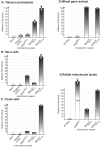
Cross-kingdom conservation of IRES
activity. Expression of the 3′-proximal GUS gene from dicistronic
CP-IRES-GUS constructs in tobacco protoplasts (A), HeLa
(B), yeast (C) cells and cell-free
translation systems WGE (D), and RRL (E).
The 72-nt synthetic GC-rich polylinker-derived (PL72)
spacer (23) (A, B) and the 148-nt region
upstream from start codon of the CP gene of TMV U1
(U1
, ref. 22) (C) were used as
negative controls. GUS gene expression in HeLa (B) and
yeast (C) cells transfected with animal cell or yeast
cell promoter-based dicistronic constructs H-GFP-IRES-GUS and
CP-IRES-GUS, respectively.
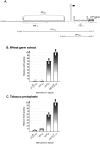
IRES deletion analysis. (A)
Simplified schematic representation of the IRES
structure (see ref. for details) and its deletion mutants. Letters
indicate the sequences of the 32-nt polypurine tract PPT32
(which includes the 19-nt element PPT19) located upstream
of the hairpin–loop structure and the 11-nt tract (PPT11)
just upstream of the CP gene, respectively. Arabic numerals indicate
the nucleotide positions in full-length crTMV genomic RNA (21). The
arrow points to the position resulting in formation of two deletion
mutants (Δ5′IREScp and Δ3′IREScp) described in ref. . The lines
indicated by PPT
and PPT
correspond to the respective IRES
deletion
mutants used in the present study. GUS gene expression by internal
translation from dicistronic constructs in WGE (B) and
tobacco protoplasts (C) under control of the intact
IRES
and its deletion mutants
(PPT
and PPT
).
UI
sequence (22) was taken as a negative
control.
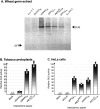
Comparative dicistronic analysis of IRES activities of multiple
G(A)3 modules and natural IRESs
(IRES and IRESEMCV) in WGE
(A), tobacco protoplasts (B), and HeLa
cells (C). Artificial sequences tested:
(i) (PPT19)4 and
(PPT19)8 representing the tandem repeats of
four (76-nt) and eight (152-nt) copies of the 19-nt AAAAGAAGGAAAAAGAAGG
sequence derived from PPT32 (see Fig. 3), respectively;
(ii) the 64-nt (GAAA)16 sequence consisting
of 16 G(A)3 elements; (iii) control U-rich
sequence (GUUU)16; (iv) the control Emp
× 4 sequence consisting of four copies of the U-rich
CGUUUGCUUUUUGUAGUA element derived from another crTMV IRES
(IRES
) and (v) the GCU-rich
sequence (GCU-R) containing four copies of CGCGGGCG blocks linked via
the 7-nt sequence UUUGUUU used as an additional negative control.
(A) Analysis of proteins directed in WGE by dicistronic
H-GFP-ICS-GUS T7 transcripts containing artificial sequences as the
intercistronic spacer. Arrows indicate the position of GUS and GFP.
(B and C) GUS gene expression in tobacco
protoplasts (B) and HeLa (C) cells
transfected with dicistronic GFP-IRES-GUS constructs containing
different IRES sequences. “Mock” indicates that DNA-free solution
was used for transfection.
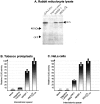
Dicistronic analysis of IRES activity of the 5′-UTR of NtHSF-1 mRNA (5′UTR NtHSF) in RRL (A), tobacco protoplasts (B), and HeLa cells (C). Tested H-GFP-ICS-GUS RNA transcripts contained as intercistronic spacers the 453-nt 5′UTR of NtHSF-1 mRNA (5′UTR NtHSF) and other synthetic sequences indicated in the legend to Fig. 4.
Similar articles
-
Skulachev MV, Ivanov PA, Karpova OV, Korpela T, Rodionova NP, Dorokhov YL, Atabekov JG. Skulachev MV, et al. Virology. 1999 Oct 10;263(1):139-54. doi: 10.1006/viro.1999.9928. Virology. 1999. PMID: 10544089
-
A tobamovirus genome that contains an internal ribosome entry site functional in vitro.
Ivanov PA, Karpova OV, Skulachev MV, Tomashevskaya OL, Rodionova NP, Dorokhov YuL, Atabekov JG. Ivanov PA, et al. Virology. 1997 May 26;232(1):32-43. doi: 10.1006/viro.1997.8525. Virology. 1997. PMID: 9185586
-
Dmitriev SE, Andreev DE, Terenin IM, Olovnikov IA, Prassolov VS, Merrick WC, Shatsky IN. Dmitriev SE, et al. Mol Cell Biol. 2007 Jul;27(13):4685-97. doi: 10.1128/MCB.02138-06. Epub 2007 Apr 30. Mol Cell Biol. 2007. PMID: 17470553 Free PMC article.
-
Hepatitis C Virus Translation Regulation.
Niepmann M, Gerresheim GK. Niepmann M, et al. Int J Mol Sci. 2020 Mar 27;21(7):2328. doi: 10.3390/ijms21072328. Int J Mol Sci. 2020. PMID: 32230899 Free PMC article. Review.
-
Elusive Trans-Acting Factors Which Operate with Type I (Poliovirus-like) IRES Elements.
Andreev DE, Niepmann M, Shatsky IN. Andreev DE, et al. Int J Mol Sci. 2022 Dec 7;23(24):15497. doi: 10.3390/ijms232415497. Int J Mol Sci. 2022. PMID: 36555135 Free PMC article. Review.
Cited by
-
Pol II-directed short RNAs suppress the nuclear export of mRNA.
Komarova TV, Schwartz AM, Frolova OY, Zvereva AS, Gleba YY, Citovsky V, Dorokhov YL. Komarova TV, et al. Plant Mol Biol. 2010 Dec;74(6):591-603. doi: 10.1007/s11103-010-9700-x. Epub 2010 Oct 17. Plant Mol Biol. 2010. PMID: 20953971
-
Robust Transgene Expression from Bicistronic mRNA in the Green Alga Chlamydomonas reinhardtii.
Onishi M, Pringle JR. Onishi M, et al. G3 (Bethesda). 2016 Dec 7;6(12):4115-4125. doi: 10.1534/g3.116.033035. G3 (Bethesda). 2016. PMID: 27770025 Free PMC article.
-
Dicistronic regulation of fluorescent proteins in the budding yeast Saccharomyces cerevisiae.
Edwards SR, Wandless TJ. Edwards SR, et al. Yeast. 2010 Apr;27(4):229-36. doi: 10.1002/yea.1744. Yeast. 2010. PMID: 20017217 Free PMC article.
-
May J, Johnson P, Saleem H, Simon AE. May J, et al. J Virol. 2017 Mar 29;91(8):e02421-16. doi: 10.1128/JVI.02421-16. Print 2017 Apr 15. J Virol. 2017. PMID: 28179526 Free PMC article.
-
Hanafy MS, El-Banna A, Schumacher HM, Jacobsen HJ, Hassan FS. Hanafy MS, et al. Plant Cell Rep. 2013 May;32(5):663-74. doi: 10.1007/s00299-013-1401-x. Epub 2013 Mar 1. Plant Cell Rep. 2013. PMID: 23455709
References
-
- Pain V M. Eur J Biochem. 1996;236:747–771. - PubMed
-
- Kozak M. Gene. 1999;234:187–208. - PubMed
-
- Dever T E. Trends Biol Sci. 1999;24:398–403. - PubMed
-
- Jackson R J. In: Translation Control of Gene Expression. Sonenberg N, Hershey J W B, Mathews W B, editors. Plainview, NY: Cold Spring Harbor Lab. Press; 2000. pp. 127–184.
Publication types
MeSH terms
Substances
LinkOut - more resources
Full Text Sources
Other Literature Sources
Molecular Biology Databases
Research Materials
Miscellaneous